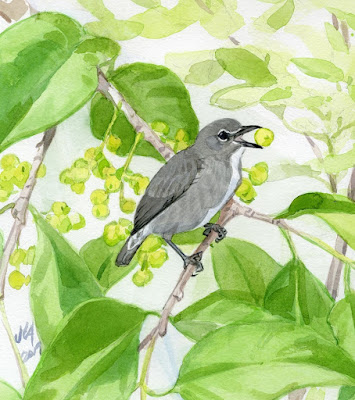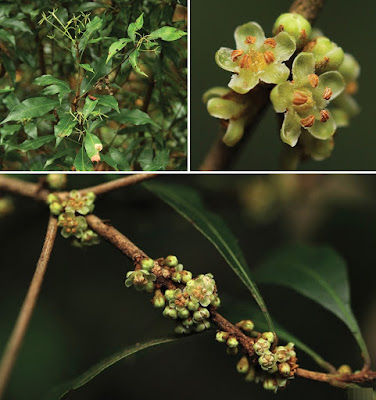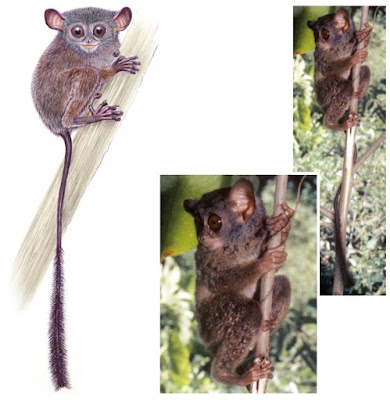[Most Recent Entries] [Calendar View]
Thursday, October 17th, 2019
| Time | Event | ||||||
| 9:25a | [Ornithology • 2019] Dicaeum dayakorum ‘Spectacled Flowerpecker’ • A Distinctive New Species of Flowerpecker (Passeriformes: Dicaeidae) from Borneo
ABSTRACT The enigmatic ‘Spectacled Flowerpecker’—a probable new bird species from the island of Borneo—was first sighted in the Danum Valley of Sabah, Malaysia in 2009. However, the absence of a holotype specimen has prevented its formal scientific description. Since then only a handful of reports from widely disparate localities across the island have emerged, all from lowland sites and often in close association with fruiting mistletoe. Here, we report the long-awaited capture of a specimen of this putative new species and confirm its morphological and molecular distinctiveness as a novel species in the genus Dicaeum. Key words: Dicaeum, holotype, canopy, mistletoe, specialist Dicaeum dayakorum, species novum Spectacled Flowerpecker Diagnosis.— Phenotypically assignable to the genus Dicaeum Cuvier, 1816, by short thin bill, specialized (bifid and semi-tubular) tongue morphology (Fig. 4), and a greatly reduced outermost primary feather (Mayr & Amadon 1947, Salomonsen 1960a,b, Morioka 1992). Diagnosable as distinct from other species of Dicaeum by the following combination of characters; (1) rows of white orbital feathers above and below the eye, forming thin, but conspicuous white arcs; (2) entirely gray and white plumage coloration with no evidence of carotenoid pigments in the adult plumage; (3) short distal bill length (6 mm from nares to bill tip). Field observations indicate that the eye-arcs of putative males are even more strongly expressed than in the female holotype. The strong white eye-arcs of D. dayakorum are unique in Dicaeidae, although traces of pale eye-arcs are known to be present in female and juvenile plumages of a few other species (e.g. D. monticolum, D. agile, D. pygmaeum). Red and yellow carotenoid pigments are evident in the plumage of most species of Dicaeum. The apparent lack of these pigments in the adult female holotype and field observations of putative adult males sets D. dayakorum apart from most of its congeners. Etymology.— We name Dicaeum dayakorum in honor of the Dayak people of Borneo. Their immense knowledge of the flora and fauna of their homeland forests is irreplaceable and crucial to future conservation efforts of Borneo’s endemic ecosystems. The English name of ‘Spectacled Flowerpecker’ is assigned as proposed by Edwards et al. (2009), and refers to the broken eye-ring that is this species’ most characteristic and easily recognized plumage feature. This name also has the benefit of established usage in the ornithological and birdwatching community. Jacob R. Saucier, Christopher M. Milensky, Marcos A. Caraballo-Ortiz, Roslina Ragai, N. Faridah Dahlan and David P. Edwards. 2019. A Distinctive New Species of Flowerpecker (Passeriformes: Dicaeidae) from Borneo. Zootaxa. 4686(4); 451–464. DOI: 10.11646/zootaxa.4686.4.1 | ||||||
| 9:52a | [Botany • 2019] Synsepalum chimanimani (Sapotaceae) • A New Species from the Chimanimani Mountains of Mozambique and Zimbabwe, with Notes on the Botanical Importance of This Area
Abstract Synsepalum chimanimani S.Rokni & I.Darbysh., sp. nov., a small tree endemic to the forests of the southern foothills of the Chimanimani Mountains of Mozambique and Zimbabwe, is described and illustrated. The differences in morphology and distribution between the new species and the related S. kaessneri and S. muelleri, with which it has been confused, are clarified. The new species is globally Endangered due to ongoing habitat loss within its restricted range. The botanical importance and conservation of the Chimanimani foothills is also discussed, and they are highlighted as a candidate Important Plant Area. Keywords: conservation, herbarium, Important Plant Area, Makurupini, taxonomy
Synsepalum chimanimani S.Rokni & I.Darbysh., sp. nov. Diagnosis: This species differs from Synsepalum kaessneri (Engl.) T.D.Penn. in the generally smaller (7.9–12.6 x 1.7–3.4 cm versus 9.8–16.7 x 2.8–5.2 cm) narrowly elliptic leaves with a long and narrow acuminate tip versus oblanceolate leaves with a short and broad acuminate tip (see illustration, Fig. 1E, L); flowers sessile or almost so with pedicels less than 1 mm long (extending to 2 mm long in fruit) versus flowers stalked with pedicels 1–3 mm long (extending to 3–5 mm in fruit); shorter corolla tube (0.75–0.8 mm long versus 1.2 mm long) and shorter (1.45–1.5 mm versus 1.8–1.9 mm), broadly ovate versus ovate corolla lobes; anthers with elliptic thecae with a minute, inconspicuous point at the apex of the connective versus arrow-head shaped anthers with oblong thecae with a conspicuous apiculate apex to the connective. Table 1 shows the distinguishing characters between the two species. Etymology: The specific epithet is taken from the Chimanimani mountains to which the species is confined.   Saba Rokni, Bart Wursten and Iain Darbyshire. 2019. Synsepalum chimanimani (Sapotaceae), A New Species from the Chimanimani Mountains of Mozambique and Zimbabwe, with Notes on the Botanical Importance of This Area. PhytoKeys. 133: 115-132. DOI: 10.3897/phytokeys.133.38694 | ||||||
| 10:29a | [Mammalogy • 2019] Tarsius niemitzi • A New Tarsier Species from the Togean Islands of Central Sulawesi, Indonesia, with References to Wallacea and Conservation on Sulawesi
Abstract We describe and name a new species of tarsier from the Togean Islands, in Tomini Bay, bounded by the northern and eastern peninsulas of Sulawesi. In doing so, we highlight how 25 years of sustained research on the alpha taxonomy of Sulawesian tarsiers, Tarsius, have helped to identify key conservation priorities in the Sulawesian region of the Wallacea Biodiversity Hotspot. Key words: Biodiversity, bioacoustics, cryptic species, duet call, Togean form, taxonomy, hotspots
Tarsius niemitzi sp. nov. Description: MORPHOLOGY: Surveys of wild populations have indicated that body weight and tail length fall within the range of a number of other Tarsius species, including T. tarsier, T. fuscus, T. dentatus, T. spectrumgurskyae, and T. supriatnai. Body weights and tail lengths may well overlap with all species of Tarsius, except T. pumilus and possibly some offshore taxa, such as T. sangirensis. Body weight: female 104−110 g (n = 2); male 125−138 g (n = 3). Tail length: female = 245−261 mm (n = 2); male 246−258 mm (n = 3) (data from Shekelle 2003). Tarsius niemitzi is similar to T. dentatus in having darkly pigmented skin, particularly the tail, and relatively dark pelage with dark gray facial fur, particularly in adults (Fig. 3). Atypical for tarsier species endemic to small islands, T. niemitzi does not have a reduced tail tuft (see Shekelle et al. 2008b). VOCALIZATIONS: Spectrograms of the Togean form were published by Nietsch and Kopp (1998) (Fig. 4). .... Diagnosis: The duet call, and the species provenance and genetics are diagnostic.
Distribution: Togean Islands, except for Una Una (Fig. 2). Etymology: Niemitz’s tarsier. This species is named in honor of Dr. Carsten Niemitz, universally regarded as the father of tarsier field biology. Although his field work was preceded by that of Fogden (1974), it was Niemitz who first dedicated a substantial part of his career to the systematic study of wild tarsiers. Niemitz and his student, Alexandra Nietsch, surveyed tarsiers in Central Sulawesi. Subsequently, reportedly acting on a tip from an Indonesian government official, Rolex Lameanda, Nietsch traveled to the Togean Islands to survey tarsiers there and, with Niemitz, was the first to report their presence and the likelihood of their taxonomic distinctiveness (Nietsch and Niemitz 1993). We have found no evidence that Tarsius togeanus (as per Surjadi and Supriatna 1998, p.281; Ito et al. 2008, p.234) and T. togianensis (as per Gursky 2007, p.5) are names arising from formal descriptions, and they are as such nomina nuda. Local Name: Bunsing, tangkasi, podi. Myron Shekelle, Colin P. Groves, Ibnu Maryanto, Russell A. Mittermeier, Agus Salim and Mark S. Springer. 2019. A New Tarsier Species from the Togean Islands of Central Sulawesi, Indonesia, with References to Wallacea and Conservation on Sulawesi. Primate Conservation. (33): For Indonesia’s newest tarsier, a debut a quarter century in the making news.mongabay.com/2019/10/tarsier-niemit |
| << Previous Day |
2019/10/17 [Calendar] |
Next Day >> |















